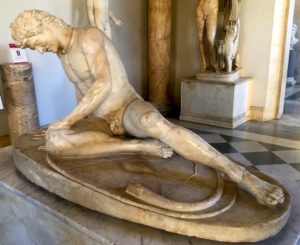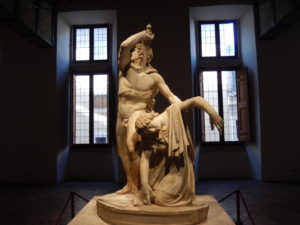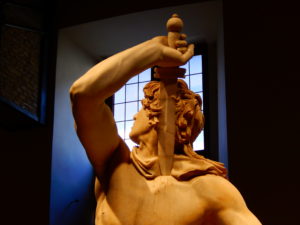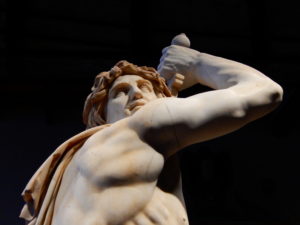Dying Gaul – Dying Galatians
Dying Gaul statues are world masterpieces made by Epigonus of Pergamum.
It is thought that the original was made of bronze and it was a part of a statuary group in Pergamum acropolis. These statues were commemorating the victory of Attalos I.st at the Battle of Caecus River in 241 BCE over the Galatians (Gauls) the celtic tribe who resided in Anatolia. Romans made marble copies of these statues around 200 BCE.
These statues serve both as a reminder of the Celts’ defeat, thus demonstrating the might of the people who defeated them, and a memorial to their bravery as worthy adversaries.
The white marble statue which may have originally been painted depicts a wounded, slumping Celt with remarkable realism particularly as regards the face. A bleeding sword puncture is visible in his lower right chest. The figure is represented as a Celtic warrior with characteristic hairstyle and moustache and has a torc around his neck He lies on his fallen shield while his sword, belt, and a curved trumpet lie beside him. The sword hilt bears a lion head. The present base was added after its 17th-century rediscovery.
The Dying Galatian became one of the most celebrated works to have survived from antiquity and was engraved and endlessly copied by artists, for whom it was a classic model for depiction of strong emotion, and by sculptors. It shows signs of having been repaired, with the head seemingly having been broken off at the neck, though it is unclear whether the repairs were carried out in Roman times or after the statue’s 17th century rediscovery.
Galatian Suicide
Roman marble group depicting a man in the act of plunging a sword into his breast, looking backwards defiantly while he supports the dying figure of a woman with his left arm.
While the plunging sword and the fallen woman confront you first, the Gaul’s flung-back head compels you to circle the statue’s entirety. Regardless of context, witnessing a suicide in action is difficult precisely because of its inherent tension between action and passivity; it is the active decision to move into a state of utter inaction. The artist has rendered this tension explicitly by portraying both states: The limp form of the deceased woman embodies the passivity that comes with death and the strong movement of the soldier impresses the forcefulness of life. The Gaul’s fierce expression suggests that this man is no coward.
This marble copy has been greatly admired as a work rendering perfect, Hellenistic proportions of the body. Interestingly, the figure is given these ideal anatomical features despite the fact that he is a barbarian. His mustache, clumped hair, and thrown-back cape are all that mark him as foreign. In the moment presented, this idealized barbarian is taking his life (and perhaps the life of the woman) before it can be taken or enslaved by his opponent. His suicide forms a preventative measure against an unbearable loss of dignity.
In conclusion we can say;
These statues are not a matter of the defeated Gauls portraying their fallen comrade with dignity and beauty. It was the victors that decided to portray their conquered enemies this way – with ideal proportions, great physical power, and commendable strength of will.
Note: Today you can see The Dying Gaul marble statue in Rome at Capitoline Museum www.museicapitolini.org/en
and The Galatian Suicide marble statue in Rome at Palazzo Altemps www.rome.net/palazzo-altemps











